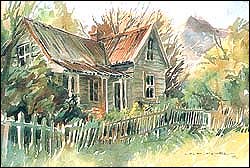Dorothy – 31/03/03
In response to many requests Bill Moore now has available occasional cards featuring eight of his New Zealand paintings. They represent a range of his painting styles and depict a number of Christchurch and Canterbury scenes, including a wintet high country scene, Akaroa and Duvauchelle on Banks Peninsula and the Worcester Street bridge and Sumner beach in Christchurch. The cards are left blank inside for the senders to put their own messages.
Banks Peninsula a favourite area Four of the paintings depict scenes on Banks Peninsula.
Akaroa The first is an oil painting of the Akaroa Harbour. It was painted on a summer day when the colours were brilliant, and Bill was attracted not only to the brilliant colour of the water but also to the pattern of shadows on the hills. He painted it on the road to the Glen looking back to Akaroa past the lighthouse.
 |
| Akaroa |
Akaroa Lighthouse This is a gouache painting – a watercolour style which gives stronger colour. Shapes are cut out and the cut out area is painted inside, as was done with the boats, houses and the lighthouse. Bill chose this painting to feature among the cards because it resembles children’s style of painting and therefore appeals to them.
 |
| Lighthouse, Akaroa Harbour |
Early Farmhouse, Banks Peninsula This watercolour shows a typical old house which can be seen on the Peninsula. It is built in the New Zealand colonial style. This choice shows Bill’s keen interest in local history.
 |
| Early Farmhouse, Banks Peninsula |
Old School House, Duvauchelle, Banks Peninsula This watercolour shows another of the old houses on the Peninsula. It can be seen down a side road near the shop at Duvauchelle, one of the small settlements on the road round the harbour to Akaroa.
 |
| Old School House, Duvauchelle |
A Canterbury river with snowy mountains in the background Rakaia River Valley, Canterbury records in oils what the painter saw on a day trip in winter on the road along the north bank which leads to Mt Algidus. This area was the subject of Mona Anderson’s widely read book, A River Rules My Life, but to reach Mt Algidus station it is necessary to ford the Wilberforce River.
Bill says that seeing the sheep on the road was unexpected, but it adds extra interest in the foreground of this oil painting and records one kind of traffic delay which often intrigues overseas visitors.
 |
| Rakaia River Valley, Canterbury |
Christchurch scenes Shag Rock, Sumner Sumner is a beach suburb near Christchurch. It attracts many visitors who appreciate its village atmosphere and enjoy walking on the beach. Such walks are favourites for Bill and Lesley and on one of the walks Bill decided to capture in oils the view looking past Shag Rock across the Avon and Heathcote Estuary towards Christchurch and the distant mountains. The scene is typical of Christchurch late on a nor’west day when the nor’west arch of cloud leaves a clear view of the mountains and the sky gilded by the setting sun.
 |
| Shag Rock, Sumner, Christchurch |
Worcester St, Christchurch Inner City – a historic area Study the painting Worcester Street Bridge Christchurch, and you will see where the gouache style has brought intensity of colour.
Again the painting speaks of history. In the background is the Christchurch Cathedral, opened in 1881, and sited to be the focal point in the city.
The wrought iron bridge dates from 1885 when it was opened by the Mayor of Christchurch, C. P. Hulbert.
The tram is one of the original electric trams which provided public transport in the city in the first half of the nineteenth century up until 1954. Restored trams began running on an inner city circuit in 1995.
 |
| Worcester Street Bridge, Christchurch |
The telephone boxes are the design which featured from the beginning of public telephone services until they were replaced by Telecom late in the twentieth century and much mourned by New Zealanders who thought that interesting little buildings had been replaced by characterless machines in metal boxes.
The brick building on the left was designed by the architect Hurst Seager to be the Christchurch City Council Chambers. The contractors were England and Martin. It was opened in 1886 by the Mayor, J. Ayers. It continued to be used as the Council Chambers until the 1920s when it became the Chamber of Commerce Building. In recent years it housed the Christchurch Information Centre, which has now moved to larger premises in the old Post Office in Cathedral Square. The building is now the home of “Our City, O tau tahi” which provides facilities for exhibitions related to the city and its history.
 |
| Burmese Friends |
Burmese Friends This painting in acrylic honours one of the artist’s firm friends – Surabaya – and features this loved cat in various poses.




